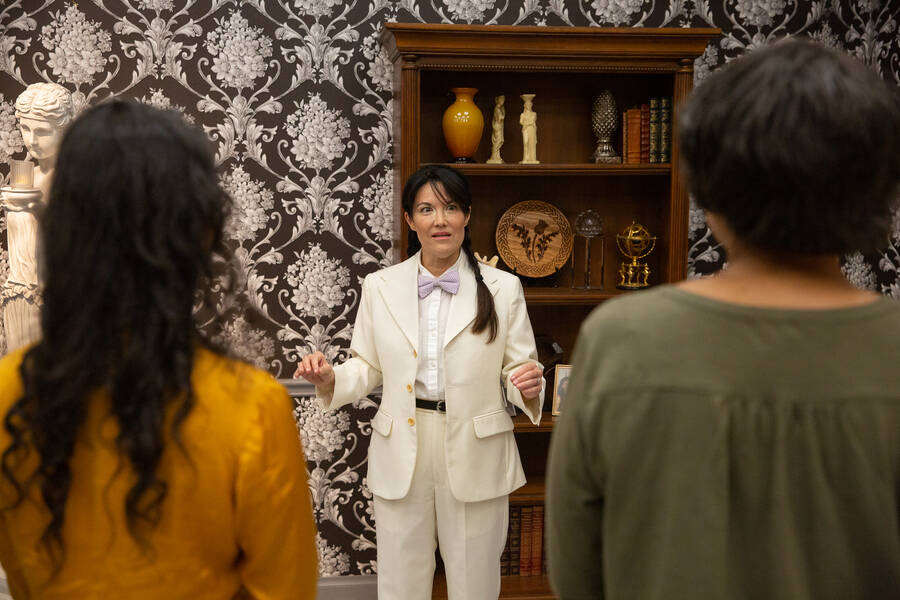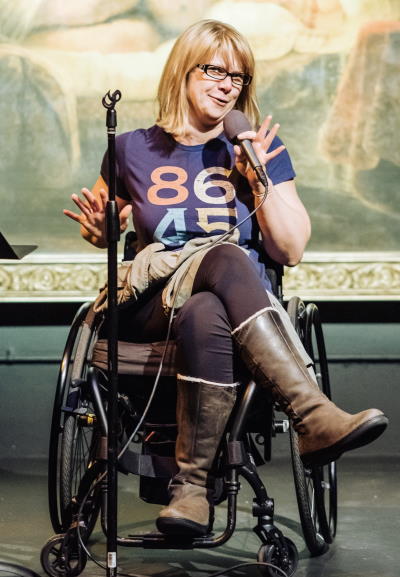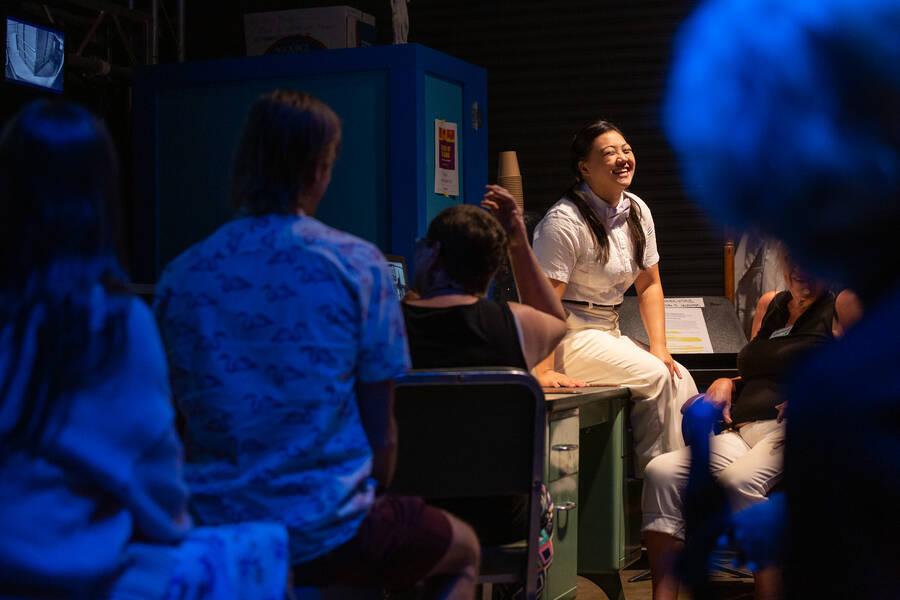Accessibility is too often a theatrical afterthought. Not so for Denver Center for the Performing Arts (DCPA), and its long-standing inclusion commitment has gone next level with its world premiere Off-Center production of Theater of the Mind (TOTM), a new immersive project from musician David Byrne and writer Mala Gaonkar, which opened last summer and has been extended through Jan. 22, 2023.
Though it was a daunting challenge, making this piece accessible to patrons with disabilities was not only doable and productive, said show producer Charlie Miller, co-founder and director of DCPA’s Off-Center program. It also was in keeping with the sensory theme of the show.
“We had a lot of concerns at the beginning,” Miller confessed. “This show incorporates neuroscience phenomena specifically targeting or involving very specific senses. We had a lot of conversations about the fact it is inherently inaccessible to some people. Our goal is to make it more accessible, not to make it perfectly accessible,” Miller said, “and to make it a meaningful experience for anyone who goes through it.”
As an example, he pointed to “visual phenomena you experience that are integral to the show, and if you are blind you cannot experience that. But we figured out how to describe it and show off different parts of the experience through touch and language. It proved that with some creativity and determination, you can make something that seems impossible to make accessible really meaningful. That’s really satisfying. It’s exactly what we were hoping to do.”
TOTM’s immersive journey takes small groups of audience members through a series of trippy rooms, each engineered to facilitate a certain “experiment.” Serving as a guide, an actor portrays a character whose backstory relates to the rooms.
“Each room is constructed to bring you on a narrative and emotional journey, but also to create the right conditions for certain phenomena—neurological and perceptual—to occur,” said TOTM director Andrew Scoville, who served as associate director on Byrne’s rock musical with Fat Boy Slim, Here Lies Love.
The show is designed to interrogate our experience of reality and the reliability of inputs we rely on in apprehending it. It asks: Can what is malleable and interpretive be trusted or prescriptive?
Scoville said that Byrne and Gaonkar “were down for anything that allows more people to access this experience and maintains the artistic integrity and narrative we’re working on.” In his collaboration with DCPA’s Miller and Denver-based accessibility consultant and theatre artist Regan Linton, Scoville said, “It was presented very early that accessibility and artistic integrity would not be in conflict—and they never were.”

It helped, Scoville continued, that “because we built the space from the ground up, it was easy to make accessibility a priority from the jump. DCPA was really front-footed about getting focus groups in and communicating with them to understand how we could make some of these sensory experiences that, on paper and at first glance, seem completely inaccessible to people with disabilities. Instead, we’ve given them an opportunity to understand or experience the intention, or implications of it.”
For Off-Center’s mounting of TOTM, accessibility was integrated into the design and mechanics of the tech-heavy sets, which fill a 15,000-square -foot warehouse that was originally a U.S. Army depot and later a cannabis grow house. The creative team feels that what’s been pulled off there is an organic approach to accessibility that is ripe for replication.
“I feel like if we can make Theater of the Mind accessible to people, then you can make anything accessible,” said Miller, whose Off-Center strives to create unexpected theatrical experiences that put audience at the center of the story. As much of Off-Center’s work is immersive and experiential, he said, “Audience members have a more active role.”
Linton, former artistic director of Denver’s disability theatre company, Phamaly, said that attention to accessibility should go beyond physical accommodations and aides to making theatre “a more cultural experience that considers how it impacts our engagement with each other when there are these physical, cognitive, intellectual differences that we can sense about each other. That’s where I think it needs to be a much deeper conversation. I think American theatre is still very much on the surface in terms of how it incorporates disability and accessibility. I think a project like this, that completely shifts how we think about everything, is a good way to begin or continue the conversation around it.”
For accessibility to be fully realized, she said, theatre must move away from autocratic tendencies that dictate rather than invite.
“It’s not all about the director’s vision,” Linton said. “It’s about all of us contributing what we have to get there, so that it’s successful for everybody and people are not having to sacrifice their comfort, safety, and artistry in order to achieve what one person wants.”

With TOTM, Linton appreciated that she was in the room where decisions get made from the start, and said she felt her advice was carefully considered.
“We wanted to really think about the people often forgotten in the designs of these sorts of things,” she said. “The idea was, how do we make the experience, maybe not the exact same for them, especially because this is based on sensory experiments, but so that it’s still a very engaging, exciting, interesting experience?”
Miller said that this ethos covers everyone’s needs being addressed through the process: actors, techs, audience members.
“The front-of-house team and backstage team communicate with chat through the performance,” Miller said. “Every audience member that comes in is given the opportunity to ask a question or share any concerns or needs. We have all these ways of alerting the backstage crew, so that if someone uses a wheelchair or crutches, we make it seamless for them so they are completely accommodated without feeling they don’t fit. We’re ready to handle whatever anyone brings and embrace it. That culture has really infused itself through our company.”
The team has also devised enhanced performances to maximize the experience for specific communities, including blind and low-vision folks (audio description), Deaf and hard-of-hearing individuals (American Sign Language), and folks with sensory needs (extended time).
“We spent a long time developing those,” Miller said. “For each, a test audience of volunteers came through to try it out. They gave us feedback and we incorporated that before we opened versions for paid audiences. There’s a lot of nuance. It has required modifications to lights and sound, and to actors’ performances or delivery of lines.”
An audio describer accompanies some groups; an ASL interpreter accompanies others. A “track” devised for mobility device users has removed any potential physical obstacles.
“We wanted to be very intentional in making sure someone in a wheelchair or with a walker or a cane would feel like we had prepared for them,” said Linton, a paraplegic wheelchair user herself. “Instead of fitting them in where they could fit, they have their own unique space created for them. It’s to make someone feel they are a part of the experience just like everybody else and they’re not being pushed to the side.”
Detailed accessibility and sensory information is provided on DCPA’s website and in show information. A detailed sensory guide is available in the lobby.

The lesson in all this, Linton suggested, is that “when it comes to true accessibility, humans are different, so one size does not necessarily fit all. What you typically find in theatre is one thing presented, and then a couple things added or thrown in on the side: a captioning screen on one day, an ASL interpreter another day. But the main thing is just what it is and it’s not very adaptable.
“We decided if you’re really going to make something welcoming, inclusive, and accessible, then it’s about building it slightly differently for what unique communities need. It required being more intentional putting time and effort into it. That basically says you’re worth us building this for you, which is often not the case in theatre.”
This has especially been the case with more participatory forms of theatre.
“Often when I hear immersive theatre, it gives me anxiety because I’m like, ‘Oh God, what am I going to have to navigate? What is going to be expected of me? Is it going to be workable for me?’” With many such shows, she said, “It doesn’t feel like I was considered in the building of it.”
But, as Miller said, this form has the chance to incorporate more accommodation, not less.
“What’s exciting about immersive to me in general is that you have the opportunity to create the whole world,” said Miller. “Literally, this was an empty warehouse we designed and built out. So there was no reason why accessibility couldn’t be thought of from the beginning, which is why we did what we’ve done for all of our shows.”
The Americans with Disabilities Act (ADA) standardizes accessibility in public spaces in terms of ramps, elevators, extra wide doors. It leaves something to be desired beyond that.
“When you’re talking about creative experiences where human beings are invited into the experience,” Linton said, “there’s no guideline or mandate for that. So it is really incumbent upon the artist or producer to say this is something important to us that we want to do. Otherwise there’s no external force that’s going to make you do it.
“We’ve seen a lot of necessary shifts or commitments by theatres to say we’ve not done well in the past in how we’ve involved different historically marginalized or underrepresented communities. But disability often gets lost in that shuffle. I think it stems from a deep fear and discomfort. Disability is often representative of people’s vulnerability and mortality. There’s deep stigma around disability. It means you can’t do something.”
But TOTM proves that a solution is within reach, Linton said. “It is possible, even with immersive theatre projects, to build them in a way that is welcoming for everybody. But it does take a line item on a budget. So why not start thinking more expansively in this way so that you’re not excluding a segment of the population?”
Leo Adam Biga (he/him) is an Omaha-based freelance writer and the author of the 2016 book Alexander Payne: His Journey in Film.


